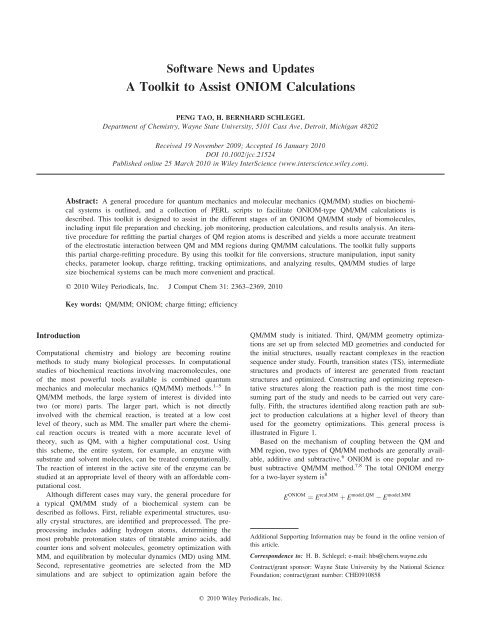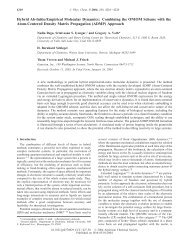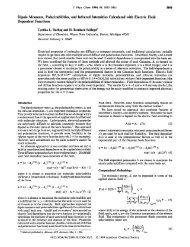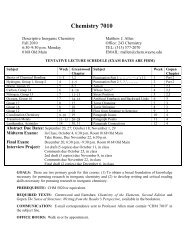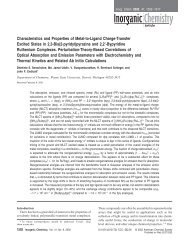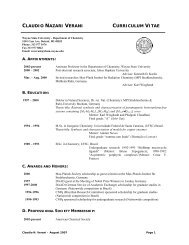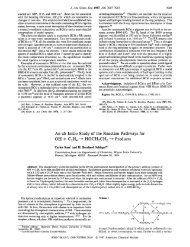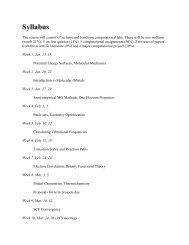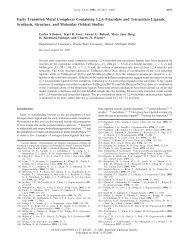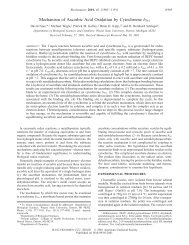A toolkit to assist ONIOM calculations - Department of Chemistry ...
A toolkit to assist ONIOM calculations - Department of Chemistry ...
A toolkit to assist ONIOM calculations - Department of Chemistry ...
Create successful ePaper yourself
Turn your PDF publications into a flip-book with our unique Google optimized e-Paper software.
S<strong>of</strong>tware News and Updates<br />
A Toolkit <strong>to</strong> Assist <strong>ONIOM</strong> Calculations<br />
PENG TAO, H. BERNHARD SCHLEGEL<br />
<strong>Department</strong> <strong>of</strong> <strong>Chemistry</strong>, Wayne State University, 5101 Cass Ave, Detroit, Michigan 48202<br />
Received 19 November 2009; Accepted 16 January 2010<br />
DOI 10.1002/jcc.21524<br />
Published online 25 March 2010 in Wiley InterScience (www.interscience.wiley.com).<br />
Abstract: A general procedure for quantum mechanics and molecular mechanics (QM/MM) studies on biochemical<br />
systems is outlined, and a collection <strong>of</strong> PERL scripts <strong>to</strong> facilitate <strong>ONIOM</strong>-type QM/MM <strong>calculations</strong> is<br />
described. This <strong><strong>to</strong>olkit</strong> is designed <strong>to</strong> <strong>assist</strong> in the different stages <strong>of</strong> an <strong>ONIOM</strong> QM/MM study <strong>of</strong> biomolecules,<br />
including input file preparation and checking, job moni<strong>to</strong>ring, production <strong>calculations</strong>, and results analysis. An iterative<br />
procedure for refitting the partial charges <strong>of</strong> QM region a<strong>to</strong>ms is described and yields a more accurate treatment<br />
<strong>of</strong> the electrostatic interaction between QM and MM regions during QM/MM <strong>calculations</strong>. The <strong><strong>to</strong>olkit</strong> fully supports<br />
this partial charge-refitting procedure. By using this <strong><strong>to</strong>olkit</strong> for file conversions, structure manipulation, input sanity<br />
checks, parameter lookup, charge refitting, tracking optimizations, and analyzing results, QM/MM studies <strong>of</strong> large<br />
size biochemical systems can be much more convenient and practical.<br />
q 2010 Wiley Periodicals, Inc. J Comput Chem 31: 2363–2369, 2010<br />
Key words: QM/MM; <strong>ONIOM</strong>; charge fitting; efficiency<br />
Introduction<br />
Computational chemistry and biology are becoming routine<br />
methods <strong>to</strong> study many biological processes. In computational<br />
studies <strong>of</strong> biochemical reactions involving macromolecules, one<br />
<strong>of</strong> the most powerful <strong>to</strong>ols available is combined quantum<br />
mechanics and molecular mechanics (QM/MM) methods. 1–5 In<br />
QM/MM methods, the large system <strong>of</strong> interest is divided in<strong>to</strong><br />
two (or more) parts. The larger part, which is not directly<br />
involved with the chemical reaction, is treated at a low cost<br />
level <strong>of</strong> theory, such as MM. The smaller part where the chemical<br />
reaction occurs is treated with a more accurate level <strong>of</strong><br />
theory, such as QM, with a higher computational cost. Using<br />
this scheme, the entire system, for example, an enzyme with<br />
substrate and solvent molecules, can be treated computationally.<br />
The reaction <strong>of</strong> interest in the active site <strong>of</strong> the enzyme can be<br />
studied at an appropriate level <strong>of</strong> theory with an affordable computational<br />
cost.<br />
Although different cases may vary, the general procedure for<br />
a typical QM/MM study <strong>of</strong> a biochemical system can be<br />
described as follows. First, reliable experimental structures, usually<br />
crystal structures, are identified and preprocessed. The preprocessing<br />
includes adding hydrogen a<strong>to</strong>ms, determining the<br />
most probable pro<strong>to</strong>nation states <strong>of</strong> titratable amino acids, add<br />
counter ions and solvent molecules, geometry optimization with<br />
MM, and equilibration by molecular dynamics (MD) using MM.<br />
Second, representative geometries are selected from the MD<br />
simulations and are subject <strong>to</strong> optimization again before the<br />
QM/MM study is initiated. Third, QM/MM geometry optimizations<br />
are set up from selected MD geometries and conducted for<br />
the initial structures, usually reactant complexes in the reaction<br />
sequence under study. Fourth, transition states (TS), intermediate<br />
structures and products <strong>of</strong> interest are generated from reactant<br />
structures and optimized. Constructing and optimizing representative<br />
structures along the reaction path is the most time consuming<br />
part <strong>of</strong> the study and needs <strong>to</strong> be carried out very carefully.<br />
Fifth, the structures identified along reaction path are subject<br />
<strong>to</strong> production <strong>calculations</strong> at a higher level <strong>of</strong> theory than<br />
used for the geometry optimizations. This general process is<br />
illustrated in Figure 1.<br />
Based on the mechanism <strong>of</strong> coupling between the QM and<br />
MM region, two types <strong>of</strong> QM/MM methods are generally available,<br />
additive and subtractive. 6 <strong>ONIOM</strong> is one popular and robust<br />
subtractive QM/MM method. 7,8 The <strong>to</strong>tal <strong>ONIOM</strong> energy<br />
for a two-layer system is 8<br />
E <strong>ONIOM</strong> ¼ E real;MM þ E model;QM<br />
E model;MM<br />
Additional Supporting Information may be found in the online version <strong>of</strong><br />
this article.<br />
Correspondence <strong>to</strong>: H. B. Schlegel; e-mail: hbs@chem.wayne.edu<br />
Contract/grant sponsor: Wayne State University by the National Science<br />
Foundation; contract/grant number: CHE0910858<br />
q 2010 Wiley Periodicals, Inc.
2364 Tao and Schlegel • Vol. 31, No. 12 • Journal <strong>of</strong> Computational <strong>Chemistry</strong><br />
Figure 1. Flowchart for a typical QM/MM study. Key steps are in<br />
rounded rectangles. Operations <strong>to</strong> connect steps are in diamond<br />
shapes. Programs developed <strong>to</strong> facilitate QM/MM studies are listed<br />
in regular rectangles.<br />
In a two-layer <strong>ONIOM</strong> QM/MM calculation, the real system<br />
contains all the a<strong>to</strong>ms (including both QM and MM regions) and<br />
is calculated at the MM level (E real,MM ). The model system is<br />
the QM region treated at the QM level (E model,QM ). To obtain<br />
the <strong>to</strong>tal <strong>ONIOM</strong> energy, the model system also needs <strong>to</strong> be<br />
treated at MM level (E model,MM ) and be subtracted from real system<br />
MM energy.<br />
Currently, the QM/MM methods implemented in the Gaussian<br />
package 9 are two- and three-layer <strong>ONIOM</strong> models for calculating<br />
the energy, gradient, and Hessian for geometry optimization<br />
and vibrational frequency analysis. <strong>ONIOM</strong> <strong>calculations</strong><br />
using Gaussian have been applied in numerous studies in computational<br />
biology, chemistry, and material science. 10–18 In a<br />
subtractive QM/MM method, such as <strong>ONIOM</strong>, the MM force<br />
field is needed for entire system, including QM region. The MM<br />
force field includes parameters for bond and nonbond interactions<br />
and partial charges. Because <strong>of</strong> its subtractive nature, most<br />
bond and short-range nonbonded terms in the QM region cancel<br />
in the <strong>ONIOM</strong> QM/MM method.<br />
Two schemes are generally applied <strong>to</strong> treat the electrostatic<br />
interaction between the QM and MM regions. 19 In the mechanical<br />
embedding (ME) scheme, this interaction is treated at the<br />
MM level. In the electrostatic embedding (EE) scheme, the partial<br />
charges <strong>of</strong> MM a<strong>to</strong>ms are included in the Hamil<strong>to</strong>nian <strong>of</strong><br />
the QM region. In the ME scheme, the electrostatic interaction<br />
between the QM and MM regions does not cancel in the QM/<br />
MM energy. The partial charges <strong>of</strong> QM a<strong>to</strong>ms play an important<br />
role in this scheme; therefore, they need <strong>to</strong> be treated carefully<br />
in QM/MM <strong>calculations</strong>.<br />
As the size <strong>of</strong> biochemical systems studied by QM/MM can<br />
be rather large, some <strong>of</strong> the structure manipulation and processing<br />
<strong>of</strong> these systems can be cumbersome. During a QM/MM calculation,<br />
it is a good practice <strong>to</strong> moni<strong>to</strong>r running jobs in terms<br />
<strong>of</strong> both energies and geometries. If problems in running jobs can<br />
be spotted at an early stage, much time and resources can be<br />
saved. However, as the sizes <strong>of</strong> structures and files in QM/MM<br />
studies can be rather large, it is not always convenient <strong>to</strong> check<br />
running QM/MM jobs on the fly, especially geometries.<br />
Although there are many graphical interfaces available <strong>to</strong> facilitate<br />
QM/MM <strong>calculations</strong>, the efficiency and convenience <strong>of</strong><br />
QM/MM studies can be substantially increased when appropriate<br />
auxiliary <strong>to</strong>ols are available for job preparation, moni<strong>to</strong>ring, and<br />
analysis. In this article, we describe a <strong><strong>to</strong>olkit</strong> <strong>to</strong> <strong>assist</strong> <strong>ONIOM</strong><br />
<strong>calculations</strong> (TAO). The <strong><strong>to</strong>olkit</strong> is written in PERL using an<br />
object-oriented design and was developed during our previous<br />
QM/MM studies. 18 With these <strong>to</strong>ols, QM/MM studies using the<br />
<strong>ONIOM</strong> method in Gaussian become much easier and more efficient,<br />
especially for large enzymatic systems. To illustrate the<br />
use <strong>of</strong> the <strong><strong>to</strong>olkit</strong> and <strong>to</strong> guide a user through an <strong>ONIOM</strong> QM/<br />
MM study <strong>of</strong> an enzymatic system, we also provide a tu<strong>to</strong>rial in<br />
the Supporting Information.<br />
In this article, the general procedure <strong>of</strong> a QM/MM study is<br />
discussed. The <strong>to</strong>ols available for the various stages <strong>of</strong> this study<br />
are listed in Table 1.<br />
<strong>ONIOM</strong> Input Preparation<br />
As many large-scale QM/MM studies are focused on biological<br />
systems, such as proteins, this article is directed mainly <strong>to</strong>ward<br />
<strong>calculations</strong> <strong>of</strong> these systems. However, this <strong><strong>to</strong>olkit</strong> can also be<br />
applied <strong>to</strong> any other system suitable for QM/MM studies. The<br />
Protein Data Bank (PDB) is a common resource for initial structures<br />
<strong>of</strong> biomolecules. The PDB file format is one <strong>of</strong> the most<br />
commonly used formats for biomolecule structure s<strong>to</strong>rage. The<br />
selected initial structures are usually subject <strong>to</strong> pretreatment by<br />
MM methods before they are used in QM/MM studies. Pretreatment<br />
typically includes geometry optimization, immersing target<br />
molecule in a box <strong>of</strong> explicit solvent molecules, equilibration by<br />
MD, etc. The resulting system after these pretreatment steps<br />
could be rather large ([10,000 a<strong>to</strong>ms). Usually, it is not necessary<br />
<strong>to</strong> keep all the solvent molecules in QM/MM <strong>calculations</strong>.<br />
For potential energy surface (PES) studies, keeping several solvation<br />
shells may be sufficient. Then, the user needs <strong>to</strong> select a<br />
QM region for the QM/MM study. This step requires a compromise<br />
between completeness <strong>of</strong> reaction site and computational<br />
cost. Because <strong>of</strong> the large size <strong>of</strong> biomolecular systems, it is a<br />
common practice <strong>to</strong> select a region within certain distance <strong>of</strong> the<br />
QM a<strong>to</strong>ms <strong>to</strong> be optimized during QM/MM study, while keeping<br />
other parts <strong>of</strong> the system frozen. This practice serves two purposes:<br />
it reduces the computational cost and avoids noise in the<br />
<strong>to</strong>tal energy from unrelated conformational changes in different<br />
parts <strong>of</strong> system other than reaction site.<br />
Journal <strong>of</strong> Computational <strong>Chemistry</strong><br />
DOI 10.1002/jcc
A Toolkit <strong>to</strong> Assist <strong>ONIOM</strong> Calculations<br />
2365<br />
Table 1. List <strong>of</strong> Programs in the Toolkit <strong>to</strong> Assist <strong>ONIOM</strong> Calculations<br />
Module Program Function<br />
Input<br />
preparation<br />
chargesum Sum up the charges in each part <strong>of</strong><br />
the <strong>ONIOM</strong> calculation<br />
checkconnect Connectivity table sanity check<br />
parmlookup Look up missing parameters in the<br />
AMBER force field<br />
pdb2oniom Generate an <strong>ONIOM</strong> input file from<br />
a PDB file<br />
pdbcore Generate a reduced size model<br />
system<br />
Job moni<strong>to</strong>ring oniomlog Check the energy and geometry and<br />
generate a new input file<br />
setmvflg Reset the optimization flag for each<br />
a<strong>to</strong>m in an <strong>ONIOM</strong> input file<br />
Production extractcharge Extract partial charges from a<br />
Gaussian log file<br />
oniomresp Facilitate the charge-refitting<br />
procedure<br />
transgeom Generate an <strong>ONIOM</strong> input file for<br />
whole system containing<br />
geometry from a reduced model<br />
system<br />
Analysis gaussiantable Compare the energies from several<br />
<strong>ONIOM</strong> output files<br />
oniom2pdb Generate a PDB file from an<br />
<strong>ONIOM</strong> file<br />
pdbcrd2oniom Replace coordinates <strong>of</strong> an <strong>ONIOM</strong><br />
input file by those from a PDB<br />
file<br />
When studying a PES for a reaction, it is necessary <strong>to</strong> identify<br />
the reactant, product, TS, and intermediates along the reaction<br />
path. As general MM methods cannot be used <strong>to</strong> study<br />
bond forming and breaking, QM/MM methods are needed.<br />
Unlike for small molecules (\100 a<strong>to</strong>ms), searching for reactants,<br />
products, and TSs in large biological systems ([5000<br />
a<strong>to</strong>ms) can be very cumbersome. Transition states can be particularly<br />
challenging. In our experience, using model QM/MM systems<br />
with reduced size can be very helpful when dealing with<br />
large systems. In early stages <strong>of</strong> a study, a large system can be<br />
reduced <strong>to</strong> a smaller model system which contains all <strong>of</strong> the<br />
QM region, the moving part <strong>of</strong> the MM region, and enough frozen<br />
part <strong>of</strong> the MM region that surrounds the first two parts (see<br />
Fig. 2). When compared with the whole system with solvent<br />
molecules, it is much easier <strong>to</strong> manipulate the reduced QM/MM<br />
model system <strong>to</strong> generate initial structures for the reactant, product,<br />
and TS, and optimizations are less costly <strong>to</strong> carry out. Of<br />
course, there will be numerous dangling bonds in the frozen<br />
MM region, but these missing bonds have little effect on the<br />
geometry optimizations in this preliminary study stage. The relative<br />
energies obtained from the reduced model system can be a<br />
guide for the production <strong>calculations</strong> on the entire system. Once<br />
a complete reaction path is identified using the reduced model,<br />
these geometries can be easily embedded back in<strong>to</strong> the whole<br />
system, because the surrounding frozen part in the reduced<br />
model has coordinates identical <strong>to</strong> the whole system. In our<br />
experience, once the initial geometries are optimized in the<br />
model system, the production geometry optimizations <strong>of</strong> the<br />
whole system are usually easy <strong>to</strong> complete.<br />
Tools for <strong>ONIOM</strong> Input Preparation<br />
Several <strong>to</strong>ols are available in TAO <strong>to</strong> <strong>assist</strong> this stage <strong>of</strong> an<br />
<strong>ONIOM</strong> study. A program named pdbcore can be used <strong>to</strong> generate<br />
a reduced-size model for a large size system s<strong>to</strong>red in a<br />
PDB file. By defining a core region with key residues, pdbcore<br />
truncates the full-size system <strong>to</strong> a reduced-size system by including<br />
residues within a certain distance (defined by user) <strong>of</strong> the<br />
core region.<br />
Program pdb2oniom can be used <strong>to</strong> generate an <strong>ONIOM</strong><br />
input file from a PDB file. There are other <strong>to</strong>ols available <strong>to</strong> do<br />
similar tasks. 20–25 However, several features make pdb2oniom<br />
particularly useful for large biomolecular systems. A list <strong>of</strong> core<br />
residues and a distance can be set by the user. The core residues<br />
are those directly involved in the chemical reactions and any<br />
other important residues <strong>of</strong> system. In the input file generated by<br />
pdb2oniom, all residues which contain one or more a<strong>to</strong>ms less<br />
than a given distance from any a<strong>to</strong>m in the core residues are set<br />
<strong>to</strong> be freely optimized (molten region). All other residues further<br />
from core residues are frozen during optimization (frozen<br />
region). Therefore, each residue as a unit will be set <strong>to</strong> either<br />
free <strong>to</strong> move or frozen. Isolated free a<strong>to</strong>ms are avoided in this<br />
setup (Scheme 1). This program uses amino acid and nucleic<br />
acid template files from AMBER 26 <strong>to</strong> assign the a<strong>to</strong>m type and<br />
partial charge for each a<strong>to</strong>m. A user can add similar template<br />
files <strong>to</strong> the library for any ligand or nonstandard residue for this<br />
purpose. The program can au<strong>to</strong>matically read these template files<br />
and apply them <strong>to</strong> the corresponding residues. These template<br />
files are usually generated by a program or constructed by the<br />
users during the MM pretreatment <strong>of</strong> the system. It should be<br />
Figure 2. <strong>ONIOM</strong> <strong>calculations</strong>. (a) Full size model, (b) reduced<br />
size model. The QM region is shown in green. Residues allowed <strong>to</strong><br />
move during optimization are in blue. Frozen residues are in red.<br />
When key structures are identified in the reduced model, they can<br />
be used <strong>to</strong> generate the full size model. The frozen a<strong>to</strong>ms in the<br />
reduced size model are used as anchors when generating the full<br />
size system model.<br />
Journal <strong>of</strong> Computational <strong>Chemistry</strong><br />
DOI 10.1002/jcc
2366 Tao and Schlegel • Vol. 31, No. 12 • Journal <strong>of</strong> Computational <strong>Chemistry</strong><br />
(GAFF.dat). 27 Users can easily replace these force field files<br />
used by parmlookup with updated force field files from newer<br />
versions <strong>of</strong> AMBER.<br />
<strong>ONIOM</strong> Job Moni<strong>to</strong>ring<br />
Scheme 1. Illustration <strong>of</strong> the optimization setup in an <strong>ONIOM</strong> calculation.<br />
A<strong>to</strong>ms shown in blue are allowed <strong>to</strong> move during geometry<br />
optimization. A<strong>to</strong>ms shown in red are frozen.<br />
noted that this program does not generate a connectivity table<br />
for the biomolecular system. Such a table can be generated<br />
using other programs such as GaussView and must be copied <strong>to</strong><br />
the end <strong>of</strong> the <strong>ONIOM</strong> input file. It is strongly recommended<br />
that the same connectivity be used for the QM region for all <strong>of</strong><br />
the structures in the reaction sequence (reactant, TS, product,<br />
etc.) <strong>to</strong> ensure comparable <strong>ONIOM</strong> energies. 8 The pdb2oniom<br />
program will not set up the QM region, as it is not a common<br />
practice <strong>to</strong> add whole residues in<strong>to</strong> the QM region. The user<br />
must explicitly choose what parts <strong>of</strong> which residues <strong>to</strong> include<br />
in the QM region for an <strong>ONIOM</strong> study using GaussView or<br />
other <strong>to</strong>ols.<br />
A correct connectivity table is important for the MM calculation,<br />
as the connectivity is used <strong>to</strong> assign partial charges and parameters<br />
for bond stretch, bend and dihedral angles, etc. The<br />
connectivity table in the <strong>ONIOM</strong> input file should be checked<br />
with the program checkconnect. This program will check for any<br />
isolated a<strong>to</strong>ms and for a<strong>to</strong>ms with <strong>to</strong>o many bond connections.<br />
These a<strong>to</strong>ms could easily disrupt an <strong>ONIOM</strong> calculation and are<br />
hard <strong>to</strong> diagnose. These a<strong>to</strong>ms can also contaminate the <strong>to</strong>tal<br />
energy significantly.<br />
Another sanity check is <strong>to</strong> sum up the <strong>to</strong>tal MM charges <strong>of</strong><br />
the whole system and <strong>of</strong> each region <strong>of</strong> the system using the<br />
program chargesum. With this <strong>to</strong>ol, the charge distribution<br />
within each region can be easily checked. It is particularly important<br />
for the QM region that the sum <strong>of</strong> MM partial charges<br />
should be close <strong>to</strong> the <strong>to</strong>tal QM charge.<br />
When running a newly generated <strong>ONIOM</strong> job for a biomolecular<br />
system that includes a small ligand, the user will most<br />
likely encounter errors due <strong>to</strong> missing MM parameters. This is<br />
because the AMBER force field does not have parameters for<br />
the substrate and for non-natural amino acids or nucleosides<br />
in the systems. The program parmlookup can be used <strong>to</strong><br />
find these missing parameters, first in the AMBER force field<br />
file (parm99.dat) and then in the general a<strong>to</strong>m force field file<br />
To maintain high efficiency in the computational study, it is a<br />
good practice <strong>to</strong> check that running jobs are producing meaningful<br />
results (both energies and geometries should be checked).<br />
When any suspicious behavior is detected for a running job, further<br />
attention may be needed before the job is finished. On the<br />
basis <strong>of</strong> the diagnosis, the job may need <strong>to</strong> be s<strong>to</strong>pped and<br />
resubmitted with suitable modification. As <strong>ONIOM</strong> geometry<br />
optimization job files for biomolecular systems can be rather<br />
large, frequent checking <strong>of</strong> the energy and geometry along the<br />
optimization path with a text edi<strong>to</strong>r or visualization program<br />
may be tedious. A number <strong>of</strong> <strong>to</strong>ols have been designed <strong>to</strong> make<br />
these tasks more convenient.<br />
Tools for <strong>ONIOM</strong> Job Moni<strong>to</strong>ring<br />
The oniomlog program was developed <strong>to</strong> facilitate job moni<strong>to</strong>ring.<br />
It can extract the energy for each component in an <strong>ONIOM</strong><br />
calculation along the optimization path and list either <strong>to</strong>tal energies<br />
in hartree or in relative values with respect <strong>to</strong> the last step<br />
<strong>of</strong> optimization in kcal/mol. With this information, users can<br />
easily follow the geometry optimization process. This check is<br />
particularly useful in detecting problems such as the energy<br />
alternating between two values rather than decreasing mono<strong>to</strong>nically.<br />
To help the user check the geometry conveniently, this<br />
program can also extract a certain portion <strong>of</strong> the system either<br />
from the last step or from all steps in the optimization path. The<br />
extracted portion can be any layer or combination <strong>of</strong> layers in a<br />
two- or three-layer <strong>ONIOM</strong> system or all a<strong>to</strong>ms not frozen in<br />
the optimization. The output file for the structure is in XYZ file<br />
format and can be visualized by many programs. 22,24,28,29 By<br />
visually inspecting the selected portion <strong>of</strong> the system, it may be<br />
possible <strong>to</strong> spot unusual behavior in the optimization before the<br />
job terminates with an error. Sometimes, it is desirable <strong>to</strong> restart<br />
an optimization job not from the last step in the current optimization<br />
attempt but from an earlier geometry along the optimization<br />
path. The oniomlog program can be used <strong>to</strong> generate a new<br />
<strong>ONIOM</strong> job file containing the geometry from a step specified<br />
by the user. With the various options provided by this program,<br />
users can moni<strong>to</strong>r multiple <strong>ONIOM</strong> jobs and generate new jobs<br />
conveniently.<br />
The setmvflg program helps a user <strong>to</strong> reset the optimization<br />
flag <strong>of</strong> an <strong>ONIOM</strong> job, for example, setting all the residues<br />
within 7 Å instead <strong>of</strong> 6 Å from core region allowed <strong>to</strong> move<br />
during optimization. The optimization flag <strong>of</strong> each a<strong>to</strong>m can be<br />
easily reset by using this program during the study without<br />
going through the whole preparation process. Caution is needed<br />
when studying different structures from a reaction sequence. To<br />
obtain a meaningful energetic pr<strong>of</strong>ile, the frozen region setup<br />
should be the same for all the structures in one reaction<br />
sequence.<br />
Journal <strong>of</strong> Computational <strong>Chemistry</strong><br />
DOI 10.1002/jcc
A Toolkit <strong>to</strong> Assist <strong>ONIOM</strong> Calculations<br />
2367<br />
<strong>ONIOM</strong> Production Jobs<br />
Once key structures in a reaction sequence (e.g., reactant, product,<br />
TS, etc.) are identified, final production <strong>calculations</strong> need <strong>to</strong><br />
be carried out. If a reduced <strong>ONIOM</strong> model system was generated,<br />
the structures found for the model system must be reoptimized<br />
for the whole system. New input files for optimizing the<br />
whole system can be generated from the optimized geometries<br />
<strong>of</strong> the reduced model.<br />
Another issue that needs <strong>to</strong> be addressed is the MM partial<br />
charges for a<strong>to</strong>ms in the QM region. For <strong>ONIOM</strong> <strong>calculations</strong>,<br />
the MM force field is required for the entire system, including<br />
QM region. The MM force field includes parameters for bond<br />
and nonbond interactions and partial charges. Because <strong>of</strong> its subtractive<br />
nature, most bond and short-range nonbond terms <strong>of</strong> the<br />
QM region cancel in the <strong>ONIOM</strong> final energy, but the electrostatic<br />
interactions between the QM and MM regions remain. In<br />
the ME scheme for <strong>ONIOM</strong> <strong>calculations</strong>, the electrostatic interactions<br />
between the QM and MM regions are calculated at the<br />
MM level based on the partial charges. Therefore, it is critical<br />
that the partial charges accurately reflect the charge distribution<br />
<strong>of</strong> the QM region. In the EE scheme for <strong>ONIOM</strong> <strong>calculations</strong>,<br />
the partial charges <strong>of</strong> the MM a<strong>to</strong>ms are included in the Hamil<strong>to</strong>nian<br />
<strong>of</strong> the QM region, and the MM partial charges <strong>of</strong> the QM<br />
a<strong>to</strong>ms play a less important role in the <strong>to</strong>tal energy than in the<br />
ME scheme. However, <strong>ONIOM</strong> geometry optimization <strong>calculations</strong><br />
using the EE scheme are generally more expensive than<br />
those with the ME scheme, especially for TS searching.<br />
Therefore, conducting ME <strong>ONIOM</strong> geometry optimization <strong>calculations</strong><br />
accurately is still a common and practical approach at<br />
present. When studying different structures in a reaction<br />
sequence, the charge distribution <strong>of</strong> the whole system changes,<br />
and a convenient method is needed for dealing with the changes<br />
in the charge distribution in a reaction sequence.<br />
The partial charges <strong>of</strong> natural amino acids and nucleosides<br />
are <strong>of</strong>ten taken from the AMBER force field. The partial charges<br />
for ligands are usually obtained from a charge-fitting process.<br />
One <strong>of</strong> the common procedures for charge fitting is the RESP<br />
method, 30,31 which was also used in the AMBER force field development.<br />
It would seem straightforward <strong>to</strong> obtain partial<br />
charges for the reactant and product and use them in QM/MM<br />
<strong>calculations</strong>. However, in many enzymatic systems, key amino<br />
acid residue side chains may form covalents bond with the substrate<br />
or may become pro<strong>to</strong>nated/depro<strong>to</strong>nated along the reaction<br />
path. In these cases, the charge distributions <strong>of</strong> substrate and residues<br />
at active site are strongly coupled. Not only the partial<br />
charges <strong>of</strong> the substrate but also those <strong>of</strong> the key residues in the<br />
active site <strong>of</strong> the protein need <strong>to</strong> be refitted in a reaction<br />
sequence <strong>to</strong> accurately reflect the structural changes.<br />
Tools for <strong>ONIOM</strong> Production Jobs<br />
A program transgeom is available <strong>to</strong> generate an <strong>ONIOM</strong> input<br />
file for the full system containing geometry from a reduced<br />
model system. This program matches each a<strong>to</strong>m from the model<br />
system <strong>to</strong> its counterpart in the full system <strong>to</strong> create a job file<br />
for the full system with the model system geometry. This program<br />
also has the ability <strong>to</strong> retain the a<strong>to</strong>m types, partial<br />
charges, optimization flags, and layer information from the<br />
model system, in case any <strong>of</strong> this setup information has been<br />
modified during preliminary study using the model system. With<br />
the optimized geometry from the model system, <strong>ONIOM</strong> optimization<br />
jobs for the full system generated by transgeom should<br />
converge rapidly. This program can also extract geometry from<br />
a full size model and build a partial model. In cases where a full<br />
frequency analysis is computationally prohibitive for the full<br />
size model but is affordable for a partial model, transgeom can<br />
be used <strong>to</strong> prepare the partial model input file with geometry<br />
from the full model. 32<br />
A program oniomresp is available <strong>to</strong> facilitate the fitting <strong>of</strong> a<br />
new set <strong>of</strong> partial charges for the QM region. This program is<br />
designed <strong>to</strong> apply the RESP charge-fitting pro<strong>to</strong>col <strong>to</strong> be compatible<br />
with the AMBER force field, but other types <strong>of</strong> partial<br />
charges from quantum chemistry <strong>calculations</strong> can also be used.<br />
This program needs an <strong>ONIOM</strong> output file as input, because the<br />
coordinates <strong>of</strong> capping a<strong>to</strong>ms (hydrogen in most cases) are<br />
needed in the charge-fitting calculation. This program works in<br />
three modes. Mode 1 generates a pure QM Gaussian input file<br />
for the QM region with capping a<strong>to</strong>ms from the <strong>ONIOM</strong> output<br />
file. This input file can be used <strong>to</strong> run a QM single point calculation<br />
for charge fitting. In mode 2, an input file for the RESP<br />
program is generated based on the QM single point calculation<br />
output file for the charge fitting. If there are any capping a<strong>to</strong>ms,<br />
it is recommended that they be constrained <strong>to</strong> have partial<br />
charges <strong>of</strong> zero. In this manner, the sum <strong>of</strong> the partial charges<br />
in the QM region will be constant and consistent for all the QM/<br />
MM <strong>calculations</strong>. This can be easily done by using a flag for the<br />
number <strong>of</strong> capping a<strong>to</strong>ms. The zero charge constraint will be<br />
added au<strong>to</strong>matically <strong>to</strong> all the capping a<strong>to</strong>ms in the input file<br />
generated for the RESP calculation. In mode 3, a new <strong>ONIOM</strong><br />
input file is generated with the partial charges <strong>of</strong> the QM region<br />
replaced by the RESP charges. Before using mode 3, an <strong>ONIOM</strong><br />
input file should be generated from the <strong>ONIOM</strong> output file used<br />
for mode 1. The program oniomlog can be used for this purpose.<br />
This <strong>ONIOM</strong> input file contains the optimized geometry from<br />
the output file and the old partial charges. This <strong>ONIOM</strong> input<br />
file and the new partial charges fitted for the QM region by<br />
RESP are input files in mode 3 <strong>to</strong> generate an <strong>ONIOM</strong> input file<br />
with the new RESP partial charges. The newly generated<br />
<strong>ONIOM</strong> input file can be used for further QM/MM geometry<br />
optimization calculation.<br />
In some cases, the user may want <strong>to</strong> refit the partial charges<br />
for different parts <strong>of</strong> the system other than the QM region.<br />
Mode 3 <strong>of</strong> oniomresp can fulfill this purpose by using a map file<br />
<strong>to</strong> match each charge <strong>to</strong> the corresponding a<strong>to</strong>m in the <strong>ONIOM</strong><br />
input file. Besides RESP, other types <strong>of</strong> a<strong>to</strong>mic charges, such as<br />
APT, NPA, or Mulliken, could be used in <strong>ONIOM</strong> <strong>calculations</strong>.<br />
Program extractcharge is designed <strong>to</strong> extract partial charges<br />
from a QM calculation and <strong>to</strong> save <strong>to</strong> a file for use with mode 3<br />
<strong>of</strong> oniomresp.<br />
It is obvious that optimization <strong>of</strong> an input file generated with<br />
mode 3 <strong>of</strong> oniomresp will lead <strong>to</strong> a different geometry. It is intuitive<br />
<strong>to</strong> repeat the charge-fitting process after the new optimization<br />
calculation. This iterative procedure can be repeated until<br />
convergence. A well-defined convergence threshold is that the<br />
Journal <strong>of</strong> Computational <strong>Chemistry</strong><br />
DOI 10.1002/jcc
2368 Tao and Schlegel • Vol. 31, No. 12 • Journal <strong>of</strong> Computational <strong>Chemistry</strong><br />
optimization from the <strong>ONIOM</strong> job with refitted charges is finished<br />
at the very first step, that is, optimization is converged<br />
without any changes in the geometry. Thus, the partial charges<br />
for the QM region represent the charge distribution <strong>of</strong> the optimized<br />
geometry. However, this optimal convergence may not be<br />
achieved easily in some cases. A less stringent criterion used in<br />
our previous study is that the difference in the <strong>to</strong>tal <strong>ONIOM</strong><br />
energies between the last two rounds <strong>of</strong> optimizations is less<br />
than 0.1 kcal/mol. 18 Obtaining this convergence typically<br />
requires four <strong>to</strong> six rounds <strong>of</strong> optimization and charge fitting.<br />
<strong>ONIOM</strong> Analysis Module<br />
After finishing the <strong>ONIOM</strong> production <strong>calculations</strong>, the geometry<br />
and energy need <strong>to</strong> be analyzed <strong>to</strong> obtain insight in<strong>to</strong> the<br />
systems under study. PDB is one popular file format for s<strong>to</strong>ring<br />
geometrical information <strong>of</strong> biomolecules. Many free and commercial<br />
graphical viewers are available <strong>to</strong> visualize and manipulate<br />
biomolecules in PDB file format. Therefore, it is convenient<br />
<strong>to</strong> convert the final geometry in<strong>to</strong> PDB format for visualization<br />
and analysis.<br />
The final <strong>ONIOM</strong> energy is calculated by subtracting the<br />
MM energy <strong>of</strong> the QM region from the MM energy for the<br />
whole system (the difference is denoted as the MM contribution)<br />
and plus the QM energy <strong>of</strong> the QM region. When studying a<br />
reaction sequence, comparisons <strong>of</strong> not only the <strong>ONIOM</strong> energy<br />
but also the QM energy and the MM contribution can be informative.<br />
Tools for <strong>ONIOM</strong> Analysis<br />
The program oniom2pdb can translate the geometry from an<br />
<strong>ONIOM</strong> input or output file <strong>to</strong> a PDB file. It reads in a PDB file<br />
and an <strong>ONIOM</strong> file and uses the PDB file as a template <strong>to</strong> generate<br />
a new PDB file containing the geometry from the <strong>ONIOM</strong><br />
file. It is recommended that the same template file be used for<br />
the various structures in a reaction sequence <strong>to</strong> ensure that all<br />
the PDB files generated in a reaction sequence have the same<br />
format. In this way, the setup for visualization can be conveniently<br />
shared among the different structures. Users may find this<br />
feature very convenient when comparing geometries and producing<br />
publication images for several structures. When using an<br />
<strong>ONIOM</strong> optimization output file <strong>to</strong> generate a PDB file, any geometry<br />
along the optimization path can be extracted with<br />
oniom2pdb and s<strong>to</strong>red in a PDB file for further analysis.<br />
Many users may find that it is easier <strong>to</strong> manipulate the geometry<br />
<strong>of</strong> biomolecules in PDB format than in other formats. Program<br />
pdbcrd2oniom can generate a new <strong>ONIOM</strong> input file with<br />
coordinates from a given PDB file. pdbcrd2oniom takes the<br />
coordinates from a given PDB file and replaces the coordinates<br />
in an existing Gaussian <strong>ONIOM</strong> input file. By contrast, pdb2oniom<br />
creates a new <strong>ONIOM</strong> input file using a PDB file. A user<br />
can easily create a PDB file with an optimized geometry from a<br />
Gaussian <strong>ONIOM</strong> file using oniom2pdb, make some changes <strong>to</strong><br />
the structure <strong>of</strong> a PDB file using their favorite <strong>to</strong>ols (<strong>to</strong> create<br />
TS, product, etc.) and then produce a new <strong>ONIOM</strong> input file<br />
with modified coordinates using pdbcrd2oniom.<br />
The program gaussiantable can read several <strong>ONIOM</strong> output<br />
files and compare the energies in these files. The <strong>ONIOM</strong><br />
energy, QM energy, and MM contribution <strong>of</strong> each file are<br />
extracted and listed in hartree. Relative energies <strong>of</strong> these components<br />
with respect <strong>to</strong> the first output file (usually the reactant as<br />
reference) are also calculated and listed in kcal/mol. This program<br />
is a convenient <strong>to</strong>ol for summarizing <strong>calculations</strong> <strong>to</strong> obtain<br />
reaction barrier heights and enthalpy changes.<br />
Conclusions<br />
A set <strong>of</strong> <strong>to</strong>ols has been developed <strong>to</strong> facilitate QM/MM calculation<br />
using the <strong>ONIOM</strong> method in Gaussian. Four modules with<br />
numerous programs were developed <strong>to</strong> <strong>assist</strong> in job preparation,<br />
moni<strong>to</strong>ring, production runs, and analysis. Each program has a<br />
brief usage message and detailed documentation. This <strong>to</strong>ol set has<br />
been used in several studies and proved <strong>to</strong> be efficient and effective.<br />
It is hoped that these <strong>to</strong>ols will make the use <strong>of</strong> <strong>ONIOM</strong><br />
<strong>calculations</strong> easier for QM/MM investigations <strong>of</strong> biochemical<br />
systems. This <strong>to</strong>ol set is available free <strong>of</strong> charge from the website<br />
http://www.chem.wayne.edu/schlegel/S<strong>of</strong>tware.html. A tu<strong>to</strong>rial on<br />
using the <strong><strong>to</strong>olkit</strong> is available in the Supporting Information.<br />
Acknowledgments<br />
The authors thank Dr. Jason L. Sonnenberg for his help during<br />
the program development, and Mr. Brian T. Psciuk and Mr. Jia<br />
Zhou for their feedback <strong>of</strong> tu<strong>to</strong>rial.<br />
References<br />
1. Gao, J. Rev Comput Chem 1996, 7, 119.<br />
2. Monard, G.; Merz, K. M., Jr. Acc Chem Res 1999, 32, 904.<br />
3. Friesner, R. A.; Guallar, V. Annu Rev Phys Chem 2005, 56, 389.<br />
4. Lin, H.; Truhlar, D. G. Theor Chem Acc 2007, 117, 185.<br />
5. Hu, H.; Yang, W. Annu Rev Phys Chem 2008, 59, 573.<br />
6. Senn, H. M.; Thiel, W. Angew Chem Int Ed Engl 2009, 48, 1198.<br />
7. Svensson, M.; Humbel, S.; Froese, R. D. J.; Matsubara, T.; Sieber,<br />
S.; Morokuma, K. J Phys Chem 1996, 100, 19357.<br />
8. Vreven, T.; Byun, K. S.; Komaromi, I.; Dapprich, S.; Montgomery,<br />
J. A., Jr., Morokuma, K.; Frisch, M. J. J Chem Theory Comput<br />
2006, 2, 815.<br />
9. Frisch, M. J.; Trucks, G. W.; Schlegel, H. B.; Scuseria, G. E.; Robb,<br />
M. A.; Cheeseman, J. R.; Scalmani, G.; Barone, V.; Mennucci, B.;<br />
Petersson, G. A.; Nakatsuji, H.; Carica<strong>to</strong>, M.; Li, X.; Hratchian, H.<br />
P.; Izmaylov, A. F.; Bloino, J.; Zheng, G.; Sonnenberg, J. L.; Hada,<br />
M.; Ehara, M.; Toyota, K.; Fukuda, R.; Hasegawa, J.; Ishida, M.;<br />
Nakajima, T.; Honda, Y.; Kitao, O.; Nakai, H.; Vreven, T.; Montgomery,<br />
J. J. A.; Peralta, J. E.; Ogliaro, F.; Bearpark, M.; Heyd, J.<br />
J.; Brothers, E.; Kudin, K. N.; Staroverov, V. N.; Kobayashi, R.;<br />
Normand, J.; Raghavachari, K.; Rendell, A.; Burant, J. C.; Iyengar,<br />
S. S.; Tomasi, J.; Cossi, M.; Rega, N.; Millam, J.; Klene, M.; Knox,<br />
J. E.; Cross, J. B.; Bakken, V.; Adamo, C.; Jaramillo, J.; Gomperts,<br />
R. E.; Stratmann, O.; Yazyev, A. J.; Austin, R.; Cammi, C.; Pomelli,<br />
J. W.; Ochterski, R.; Martin, R. L.; Morokuma, K.; Zakrzewski, V. G.;<br />
Voth,G.A.;Salvador,P.;Dannenberg,J.J.;Dapprich,S.;Daniels,A.<br />
D.; Farkas, O.; Foresman, J. B.; Ortiz, J. V.; Cioslowski, J.; Fox, D. J.<br />
Gaussian 09 Revision A.1, Gaussian, Inc.: Wallingford, CT, 2009.<br />
10. Li, J.; Cross, J. B.; Vreven, T.; Meroueh, S. O.; Mobashery, S.;<br />
Schlegel, H. B. Proteins 2005, 61, 246.<br />
Journal <strong>of</strong> Computational <strong>Chemistry</strong><br />
DOI 10.1002/jcc
A Toolkit <strong>to</strong> Assist <strong>ONIOM</strong> Calculations<br />
2369<br />
11. Kwiecien, R. A.; Khavrutskii, I. V.; Musaev, D. G.; Morokuma, K.;<br />
Banerjee, R.; Paneth, P. J Am Chem Soc 2006, 128, 1287.<br />
12. Hall, K. F.; Vreven, T.; Frisch, M. J.; Bearpark, M. J. J Mol Biol<br />
2008, 383, 106.<br />
13. Srivab, P.; Hannongbua, S. Chem Med Chem 2008, 3, 803.<br />
14. Suresh, C. H.; Vargheese, A. M.; Vijayalakshmi, K. P.; Mohan, N.;<br />
Koga, N. J Comput Chem 2008, 29, 1840.<br />
15. Li, X.; Chung, L. W.; Paneth, P.; Morokuma, K. J Am Chem Soc<br />
2009, 131, 5115.<br />
16. Alzate-Morales, J. H.; Caballero, J.; Gonzalez-Nilo, F. D.; Contreras,<br />
R. Chem Phys Lett 2009, 479, 149.<br />
17. Lundberg, M.; Kawatsu, T.; Vreven, T.; Frisch, M. J.; Morokuma,<br />
K. J Chem Theor Comput 2009, 5, 222.<br />
18. Tao, P.; Fisher, J. F.; Shi, Q.; Vreven, T.; Mobashery, S.; Schlegel,<br />
H. B. Biochemistry 2009, 48, 9839.<br />
19. Bakowies, D.; Thiel, W. J Phys Chem 1996, 100, 10580.<br />
20. GaussView version 5,Gaussian, Inc.: Wallingford, CT.<br />
21. Chem3D. version 8.0, CambridgeS<strong>of</strong>t Corporation, Cambridge, MA.<br />
22. Hanson, R. Jmol: an open-source Java viewer for chemical structures<br />
in 3D. version 11, 2008 http://www.jmol.org/.<br />
23. Portmann, S.; Luthi, H. P. Chimia 2000, 54, 766.<br />
24. Schaftenaar, G.; Noordik, J. H. J Comput Aided Mol Des 2000, 14,<br />
123.<br />
25. Allouche, A. R. Gabedit is a free Graphical User Interface for computational<br />
chemistry packages. version 2.2.9, 2009 Available at:<br />
http://gabedit.sourceforge.net/.<br />
26. Case, D. A.; Cheatham, T. E., III; Darden, T.; Gohlke, H.; Luo, R.;<br />
Merz, K. M., Jr.; Onufriev, A.; Simmerling, C.; Wang, B.; Woods,<br />
R. J. J Comput Chem 2005, 26, 1668.<br />
27. Wang, J.; Wolf, R. M.; Caldwell, J. W.; Kollman, P. A.; Case, D.<br />
A. J Comput Chem 2004, 25, 1157.<br />
28. Humphrey, W.; Dalke, A.; Schulten, K. J Mol Graph 1996, 14, 27.<br />
29. DeLano Scientific. PyMol. DeLano Scientific: Palo Al<strong>to</strong>, CA, USA,<br />
2002.<br />
30. Bayly, C. I.; Cieplak, P.; Cornell, W.; Kollman, P. A. J Phys Chem<br />
1993, 97, 10269.<br />
31. Cornell, W. D.; Cieplak, P.; Bayly, C. I.; Kollmann, P. A. J Am<br />
Chem Soc 1993, 115, 9620.<br />
32. Tao, P.; Fisher, J. F.; Shi, Q.; Mobashery, S.; Schlegel, H. B. J Phys<br />
Chem B 2010, 114, 1030.<br />
Journal <strong>of</strong> Computational <strong>Chemistry</strong><br />
DOI 10.1002/jcc


